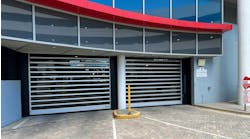In June 2020, the U.S. Green Building Council (USGBC) unveiled four new pilot credits for buildings that are meant to address sustainability needs for FMs and project teams in the time of COVID-19.
The credits outline some best practices for sustainability—in the areas of disinfection, workplace re-occupancy, IAQ and water quality—that also align with public health guidelines.
Melissa Baker, senior vice president of the USGBC, says LEED’s steering committee and technical advisers, experts and other volunteers worked together to form the new Safety First Pilot Credits, gathering data and working out in the field to answer some basic questions.
“Our community was able to come together and step up and help us respond quickly,” she says, adding: “We knew that we’d need to be able to support project teams as they were out there working, whether it be for existing buildings or planning on new construction. We tapped into our volunteer experts, talked with them about what was going on and where we needed to focus our time and effort.”
4 New LEED Pilot Credits
These credits can be used by LEED projects that are certified or are undergoing certification.
1. Safety First: Cleaning and Disinfecting Your Space.
This credit requires buildings to follow LEED’s green cleaning best practices, and it also meets the guidelines of the U.S. Centers for Disease Control and Prevention (CDC) relative to COVID-19. “Luckily, the cleaners and disinfectants that fall under green cleaning are also effective against the virus,” Baker says. “We were able to tap into a credit around that to help people understand what needed to be done and how to do it well, and also how to communicate with the occupants.”
2. Safety First: Re-Enter Your Workspace.
For this credit, LEED consulted the American Institute of Architects (AIA) and its Reoccupancy Assessment Tool, which requires transparent reporting and evaluating decisions to encourage continuous improvement. The credit also requires that buildings have a re-entry plan that includes things like access control, social distancing, touch point reduction and communication.
3. Safety First: Building Water System Recommissioning.
For buildings that have been closed for weeks or months, low or non-existent occupancy can cause issues within the building’s water system, including stagnant water that is unsafe to drink or use. With guidelines from the CDC and U.S. Environmental Protection Agency (EPA), this credit requires buildings to develop and implement a water management plan, coordinate with local water and public health authorities, and communicate water system activities and associated risks to occupants—as well as take steps to address water quality.
[Related: COVID-19: What You Need to Know About Air Filters]
4. Safety First: Managing Indoor Air Quality During COVID-19.
This credit builds on LEED’s existing IAQ requirements and credits and requires buildings to determine temporary adjustments to their ventilation approach that might minimize the spread of COVID-19 through the air. It also incorporates guidelines from the CDC. “Because these are pilot credits, we can really hear feedback and learn and iterate as we know more about the virus and hear from project teams that are using [these credits],” Baker says.
Health and Wellness
Baker notes one thing LEED emphasizes is measurement, which helps keep track of a building’s performance. Keeping data and looking at how things are going over time is one key to success.
So is “understanding that there will be a lot of plans put in place, but also maintenance of the plan,” Baker explains. “Getting feedback from users, making sure it’s actually working the way you intended. If they’re not working, that means adjusting and considering ways to find additional information so that we are tracking and making sure things are working the way they’re intended to.”
While refining and building on these credits, Baker says she’s confident that buildings can still be sustainable, even when implementing many coronavirus-related changes.
“I’ve definitely seen different paths for sustainability to continue and to enhance around public health,” she explained. “It’s not separate. Health and wellness is very critical to sustainability. As part of our strategy for healthy people and healthy spaces, that’s really the fastest way to rebuild a healthy economy. This may cause us to rethink some things or look at different solutions. We want to be there every step of the way and continue to provide that support.”



